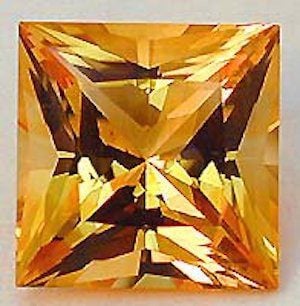Gram Princess: Online Faceting Designs and Diagrams
Introduced in 1960, the classic princess by A. Nagy was an economical cut for flat diamond crystals. However, this popular design doesn’t lend itself very well to colored gemstones. The Gram Princess by Jeff Graham is a redesign of the princess cut suitable for saturated gems.
2 Minute Read
You can find cutting instructions for the Gram Princess here.
Regarding Princesses
Very often, my customers ask me for princess-cut gems. Originally designed for shallow diamond rough, this cut made it possible for faceters to use odd bits of material. Unfortunately, the princess cut for diamonds doesn't work well with the lower refractive indices (RIs) of colored gemstones. So, I decided to redo the entire cut for colored gems.
Please note that I made quite a few changes and recalculations to the original cut. I wanted to get a design that would cut well in colored material but still have the overall feel of a princess cut. However, the original princess design concept isn't mine. I want to make that clear.
Since this isn't a "traditional princess," I named my cut the "Gram Princess." It will work well in almost any material, particularly saturated stones. I also like it in zircon and sapphire.
Cutting Remarks
You can cut the Gram Princess in RIs 1.62 to 1.93 with no changes. If you want to cut this in quartz (70%), just add 2° to all of the pavilion tiers. No changes on the crown. On any of the higher RI materials, you can also raise the crown 4 to 6° without changing the light return much.
Changing the angle of the C3 tier by a degree or so, up or down, will change the overall size of the table quite a bit. It's a good trick to use if your stone needs a little more or less area when you're cutting it.
Although the Gram Princess isn't especially hard to cut, the meets on the corners of the pavilion are tight. You could cut through them easily.
Notes on the Ray Trace
Here's something else that might interest you. Look at the ray trace at the bottom of this article. Notice the dark areas in the four corners of the design? These areas are actually trapping light rays. This explains why they look dark in the ray trace. The ray trace loses track of them and doesn't count them in the brightness figure. (At least, I don't think it does).
Now, look at the photos of the cut stone. See anything interesting? These areas are actually returning light. In fact, their color looks a little more intense than the rest of the stone's. That's because of the trapped light rays.
The light ray trace is a good indication of the overall look of a stone. However, it's not perfect. I've noticed this phenomenon in other gem designs I've published, but the Gram Princess and these pictures really illustrate this well.
Enjoy cutting your Gram Princess.
Detailed faceting instructions by Jeff Graham available at The Rock Peddler
Jeff R. Graham
The late Jeff Graham was a prolific faceter, creator of many original faceting designs, and the author of several highly-regarded instructional faceting books such as Gram Faceting Designs.
Related Articles
Cut Corner Crazy Tri : Faceting Design Diagram
Malt Square: Faceting Design Diagram
Queen Aqua: Faceting Design Diagram
Guest Designers Online Faceting Designs & Diagrams: North Star
Latest Articles
Ruby and Sapphire Survey: Where Do You Draw the Line?
Quartz Toxicity: Understanding the Risks for Jewelers and Wearers
Synthetic Amethyst: What is it and How is it Made?
Hambergite Value, Price, and Jewelry Information
Never Stop Learning
When you join the IGS community, you get trusted diamond & gemstone information when you need it.
Get Gemology Insights
Get started with the International Gem Society’s free guide to gemstone identification. Join our weekly newsletter & get a free copy of the Gem ID Checklist!
